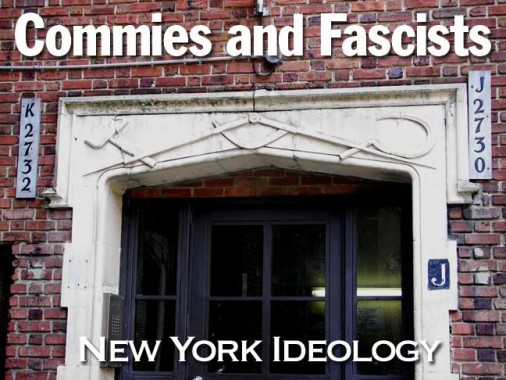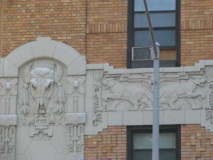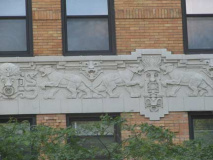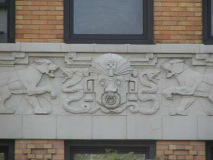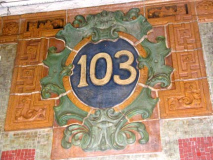Mike Tyson wears a Mao tattoo. Thousands wear T-shirts depicting Che Guevara. (Dozens wear the Forgotten NY T-Shirt). Communist ideology has produced totalitarian governments that enslaved and murdered millions throughout the decades, but there are still people who keep the dream hanging on. Ah well. FNY isn’t a political site; Lord knows we have a lot of them already. Your webmaster is a hopelessly independent voter, and this is one area where your webmaster is outgunned and outmanned. Just ask my friends.That doesn’t mean, though, that we can’t depict the symbols of the 20th century’s geat ideological struggles — which still crop up now and then, shockingly, as you traverse the streets of NYC…most evidently, on the Upper West Side of Manhattan and in Bronxdale…
Right side of a bad thing?
“Cliff Dwellers” Apartments…
…and one of its swastikas
The building, according to the AIA Guide to Architecture,is called the Cliff Dwellers Apartments, and other friezes on the building depict mountain lions, buffalo skulls and rattlesnakes to symbolize Arizona cliff dwelling Native Americans: this building overlooks hilly Riverside Park across the street.Two terra cotta swastika-shaped symbols can be found on the upper corners at 243 Riverside at West 96th Street, which was built about 1914. The swastika, formerly a symbol of good fortune and prosperity for thousands of years, was co-opted and forever corrupted, at least in the West, by the National Socialist Party of Germany beginning in the 1920s.
Sometimes swastikas can be more subtly employed. They appear in many of the plaques that were designed by Heins and LaFarge for theoriginal 28 stations of the NYC subway: look closely at the side panels.
At times, swastikas were used in tile and terra cotta decoration on pre-World War II buildings and, as we’ve seen here, some do survive.
Till the 1990s your webmaster was unaware of the swastika’s lengthy history; I was shocked to wander into Blue Star, a market in the center of Flushing (Roosevelt Avenue and Main Street) and found dozens of little bottles in the back of the store with labels rendered completely with Chinese or Korean characters…except for a large swastika emblazoned in the center. I knew they weren’t Nazi sympathizers, so my research led me to new information. Swastikas are now rarely found in the West, understandably enough, but in the East they are still widely used.
Forgotten Fan Mike Olshan: As for the swastika, which appears in Buddhist art as a rotational symbol and in Native American art as well, it was a popular good-luck signifier long before it was co-opted by the Nazis. I have a few specimens of brass coin-shaped tokens bearing the swastika as a lucky sign. One of them was issued by the Boy Scouts, as a pocket piece to be given to every Scout who bought the official BSA shoe from Thom McAn. Another one I have appears to have been a promotional item for a mining company in the southwest.
Neither of these brass pieces was designed with evil intent. But in the box with them I have one that is evil indeed. It is a brass disk with KKK punched out, intended to identify a member in good standing of the Invisible Empire. The sort of thing you’d carry in your wallet in the south to show to a cop who stopped you for speeding, so he’d let you off with a warning.
The hammer and sickle has long been used by the Communist Party as a symbol of the union of the workers (the hammer) and the proletariat, or the peasants (the sickle). It was introduced on the Soviet flag in 1922, replacing the earlier hammer and plough. Angola’s flag and Communist Parties in Britain,Israel, the USA and Guadeloupe use variants of the symbol, and Russia’s airline, Aeroflot, still does. As does a co-op in the Bronx….
The Allerton Avenue Co-Ops, Allerton Avenue and Bronx Park East in Bronxdale, were designed by the architects Springsteen and Goldhammer between 1927 and 1929. The buidlings were sponsored by unionized Eastern European Jewish garment workers; the hammer and sickle chiseled elements above the doors can still be found in the development’s First House. Don Gilligan
7/12/07
